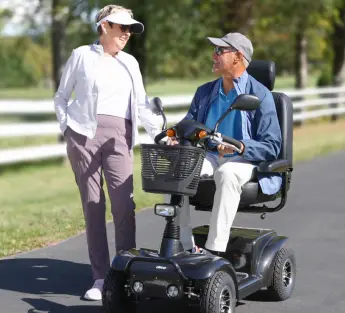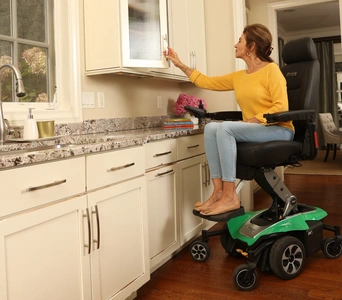Electric wheelchairs can be transformative mobility aids that empower individuals facing mobility challenges with greater independence and freedom. Unlike manual wheelchairs, these motorized devices enable users to navigate their environments effortlessly, making them invaluable for those with limited physical capabilities.
The history of electric wheelchairs traces back to the 1950s, marking a significant advancement in mobility technology. Pioneers like George Klein contributed to their development, aiming to improve the lives of World War II veterans. Today, companies continuously look to innovate and improve power wheelchairs to enhance user comfort and functionality. As a crucial role in fostering independence, electric wheelchairs allow people with mobility issues to engage more fully in daily activities and enhance their overall quality of life.
What Are the Types of Power Wheelchairs?
Power wheelchairs are categorized based on their functionality, size, and the sophistication of their seating and control systems. This categorization helps users and providers determine the most suitable option based on the user's specific needs and lifestyle.
- Group 1 Power Wheelchairs are compact and portable, designed for users who need basic mobility assistance. Ideal for indoor use, these chairs often have limited customization options but offer the advantage of being lightweight and easy to transport.
- Group 2 Electric Wheelchairs are a step up, offering more durable frames, enhanced battery life for longer distances, and speeds up to approximately 4 mph. They are suitable for users who are more active and may require a moderate level of support for daily mobility. Group 2 chairs can feature mid front and rear-wheel drive options for better indoor maneuverability and may start to include basic seating adjustments for increased comfort.
-
Group 3 Motorized Wheelchairs
are the most advanced, designed for individuals with
significant mobility challenges who require custom seating and advanced power seat adjustments and
alternative drive controls. These chairs can support multiple power seat functions, such as tilt,
recline, and elevating leg rests, catering to users with complex needs for posture support and skin
protection.
Each group serves different user requirements, from basic mobility assistance to complex needs requiring highly customizable solutions. When selecting a power wheelchair, consider the user's daily activities, environments they frequent, and the level of support needed to enhance their mobility and quality of life effectively.
For more information on selecting the right power wheelchair and understanding the differences between the groups, consulting with a healthcare provider or a mobility equipment expert, like SpinLife, is recommended.
What is the difference between an electric wheelchair, a power chair, and a motorized wheelchair?
- Electric Wheelchair: This term is widely used to describe a wheelchair that is powered by electricity, usually through batteries. It emphasizes the wheelchair's reliance on electric power for mobility, as opposed to manual propulsion by the user or an attendant.
- Power Chair: "Power chair" is a modern term that also refers to wheelchairs powered by electric batteries. It is often used to denote models that are designed for more extensive mobility and functionality. Power chairs typically come with advanced features such as customizable control systems, varying speeds, and the capability to navigate diverse terrains. They are perceived as offering more sophisticated technology and options for users who need significant mobility assistance.
- Motorized Wheelchair: This term is essentially synonymous with electric wheelchair and power chair, highlighting the motor as the key component providing mobility. "Motorized wheelchair" can be used broadly to encompass any wheelchair model that utilizes a motor for movement, offering a general descriptor that includes all electrically powered chairs.
Despite these nuances, in practice, the terms are used interchangeably by manufacturers, retailers, and users. Regardless of the preferred phrasing, when selecting a wheelchair, the focus should be less on what it is called and more on the specific features, capabilities, and suitability for the user's needs.
Key Features of Electric Wheelchairs
- Batteries determine the chair's range and require careful consideration of type and capacity.
- Motors provide the power necessary for movement, with different types offering varying speeds and torque.
- Controls, typically joysticks, allow for easy navigation, while alternative control options cater to users with limited hand mobility.
- Tires and seating systems affect comfort and accessibility, with options available to suit different environments and user preferences.
Understanding the key components that make up electric wheelchairs is crucial for anyone considering this type of mobility aid. Each element plays a significant role in the wheelchair's overall performance and user experience, which all contribute to choosing the right wheelchair.
Selecting the Right Electric Wheelchair
- User Mobility Needs: Assess whether the chair will be used predominantly indoors, outdoors, or both.
- Terrain: Consider the types of surfaces the wheelchair will need to navigate.
- Cost and Durability: Balance budget constraints with the need for a durable, long-lasting chair.
- Weight Capacity and Comfort: Ensure the chair can comfortably support the user's weight and fits their body shape and size.
Additionally, users should consider not only the size category, but also the drive wheel location, as there are specific advantages and considerations when choosing.
- Optimal for outdoor use and maneuverability on all terrains.
- Smooth ride with fewer wheels on the ground.
- Easier to navigate tight corners and get closer to counters and sinks.
- Slightly longer learning curve.
- May require adjustment in turning strategy for users with cognitive or perceptual difficulties.
- Tightest turning radius for 360° turns.
- Intuitive driving with the user's center of gravity over the drive wheel.
- Stable with six wheels on the ground.
- Can get stuck on uneven terrain or when transitioning grades due to smaller caster wheels.
- Best for high-speed performance and handling aggressive terrain.
- Tracks straight, offering stability.
- Large turning radius, making it difficult to maneuver in tight spaces.
- May feel tippy rearward.
Evaluating popular brands and models against these criteria will help identify a wheelchair that aligns with the user's lifestyle and mobility needs.
What is the best type of wheelchair?
- Golden Technologies LiteRider Envy: This model is favored for its balance between portability and functionality. It's a lightweight, compact power wheelchair that doesn't sacrifice performance, making it ideal for users seeking a blend of convenience and reliability.
- Pride Jazzy 600 ES: Known for its excellent performance both indoors and out, this wheelchair offers superb stability and durability thanks to its Enhanced Stability Technology. It's designed for users who require a dependable wheelchair that can navigate a variety of terrains.
- Pride Jazzy Carbon: Standing out for its ultra-lightweight design, the Jazzy Carbon is crafted with carbon fiber, making it one of the lightest power wheelchairs on the market. It's perfect for active users who value ease of transport without compromising on strength and durability.
- Pride Go-Chair: Renowned for its portability and ease of use, the Go-Chair is a great option for users looking for a power wheelchair that can easily be taken on the go. It combines performance with a simple, user-friendly design.
- Jazzy Air: Distinguished by its elevating seat feature, the Jazzy Air allows users to raise their seat height up to 10 inches on the go, enhancing social interaction and accessibility without compromising on mobility.
Each of these wheelchairs caters to different user needs – from those prioritizing portability to those needing enhanced stability for varied terrains. Ultimately, the best type of wheelchair depends on the user's lifestyle, mobility requirements, and personal preferences.
Final Thoughts
Electric wheelchairs are more than just mobility aids; they are lifelines that offer users independence and the ability to participate more actively in life. When selecting an electric wheelchair, it's crucial to consider personal needs, preferences, and the technical aspects of the chair to find the perfect match. SpinLife is committed to helping individuals navigate these choices, providing a wide range of electric wheelchairs from reputable brands, along with expert advice and support services.
Explore SpinLife's selection of electric wheelchairs to discover the right mobility solution for you, and take the first step toward enhanced freedom and independence.





 Contact Us
Contact Us
 M-F 9am - 6pm ET
M-F 9am - 6pm ET
 Request parts
Request parts Request Service
Request Service

